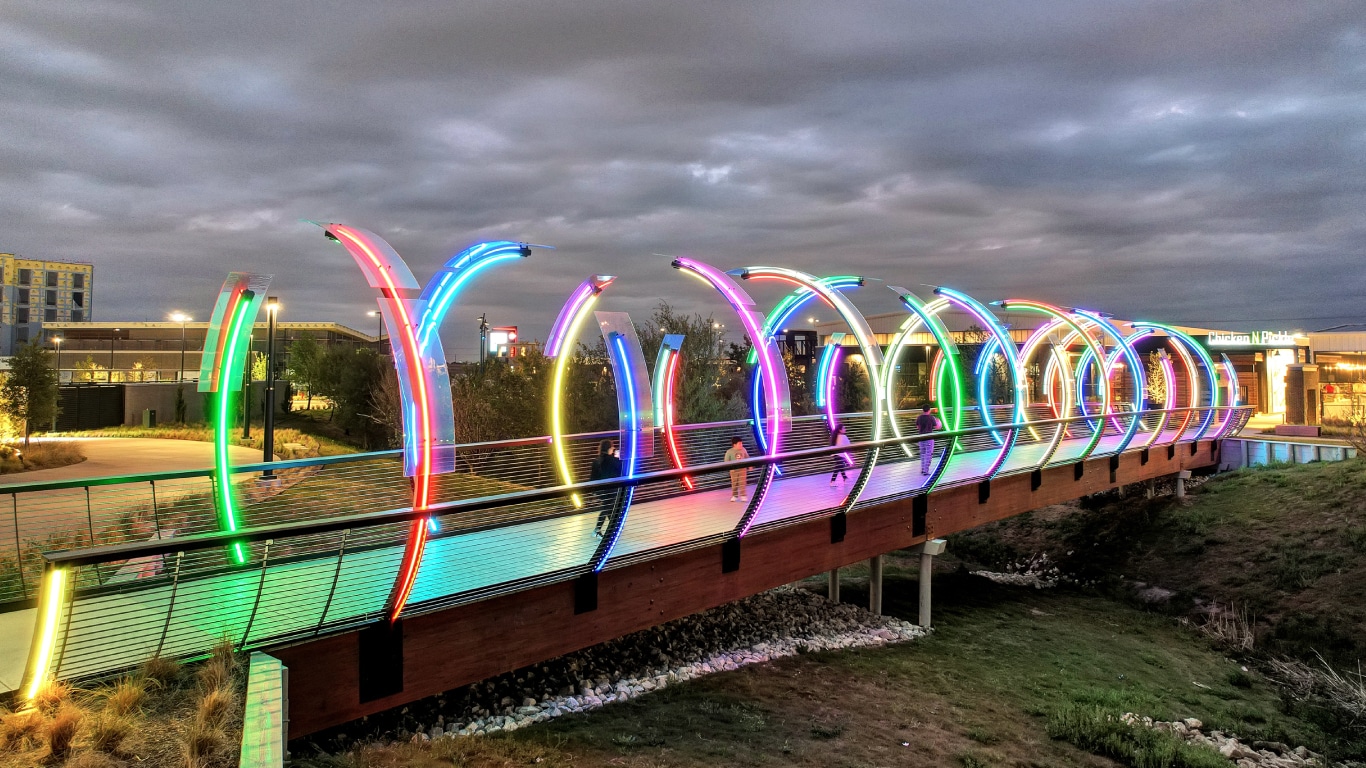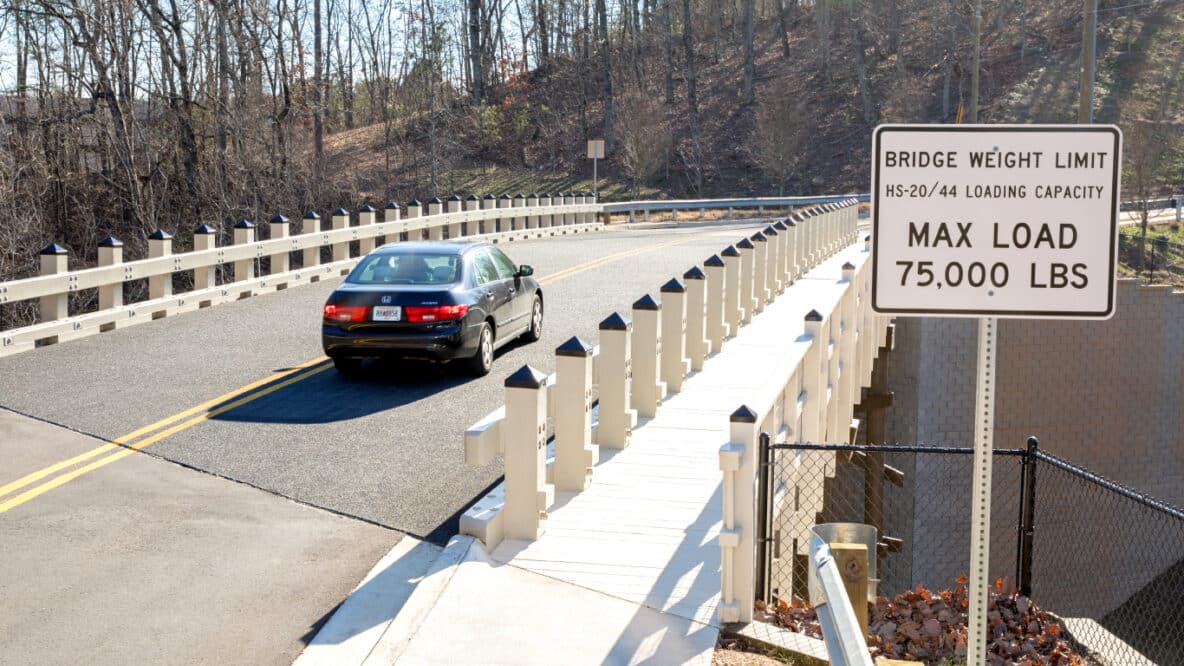Advantages Of timber Bridges
The choice between timber versus a steel bridges extends beyond it's structure, environmental impact must be considered when beginning your crossing project. It encompasses the environmental impact of the chosen material. York Bridge Concepts, the premier timber bridge builder, is committed to sustainable practices. See the environmental impacts of timber vs. steel bridges and how York Bridge Concepts offers a sustainable choice.
1. Aesthetic Appeal of Timber Bridges versus Steel Bridges
The aesthetics of a timber-built bridge versus a steel-built bridge offer distinct visual experiences. Timber bridges, with their warm, natural tones and organic textures, often blend harmoniously with their surrounding landscapes. These structures exude a timeless charm and can evoke a sense of tranquility and connection to nature. The wooden elements of timber bridges create a rustic and inviting atmosphere, which makes them popular choices for scenic and historic locations, parks, and pedestrian walkways. However, YBC pushes the envelope when it comes to aesthetics building contemporary and modern designed bridges with timber. Our galleries and portfolio exemplify some of these types of designs utilizing alternative materials into the design.

On the other hand, steel bridges have a more modern and industrial appearance, characterized by sleek lines and a metallic finish. They often reflect a sense of strength and durability, making them suitable for urban settings and areas where a more contemporary look is desired. Steel bridges can be iconic landmarks, symbolizing progress and technological achievement.
Ultimately, the choice between timber and steel bridges is a matter of balancing aesthetics with functional requirements and the surrounding environment, with each material offering its unique visual appeal.
2. Timber Bridges Have The Advantage When It Comes To Eco-Friendliness
Timber bridges hold a distinct advantage in terms of eco-friendliness when compared to their steel counterparts. Timber is a renewable and sustainable resource that, when sourced responsibly, ensures the long-term health of forests. Sustainable forestry practices, such as replanting and selective harvesting, promote the preservation and growth of trees, which play a crucial role in carbon sequestration. See Greenly's calculation comparison of a timber-built bridge versus a steel-built bridge structure.
Timber bridges inherently possess a lower carbon footprint as the production process requires less energy and generates fewer emissions compared to steel production, which is energy-intensive and carbon-emission-heavy. York Bridge Concepts' commitment to Ecotecture aligns with the eco-friendly nature of timber.
Furthermore, timber bridges can actually act as carbon sinks, absorbing and storing carbon dioxide over time, thereby reducing the overall greenhouse gas effect. Their low impact on the environment during construction and minimal maintenance requirements make them an eco-friendly choice that aligns with the principles of sustainability and responsible resource management.
In a world increasingly concerned with environmental conservation, timber bridges offer an attractive and ecologically sound solution for infrastructure development.

3. Timber Bridges Have The Advantage In Cost-Efficiency
Cost efficiency is a noteworthy advantage of timber-built bridges compared to their steel counterparts. Timber bridges typically involve lower construction costs, as the raw material, sustainably sourced timber, is often more affordable than steel. Additionally, the construction process for timber bridges can be quicker and less labor-intensive, further reducing expenses.
Maintenance costs are significantly lower for timber bridges, as they are less prone to corrosion and require less frequent inspections and repairs compared to steel bridges. This translates into long-term savings, making timber-built bridges a cost-effective choice for budget-conscious projects, while still ensuring structural integrity and reliability.
Moreover, the sustainability of timber as a construction material aligns with environmental and budgetary considerations, as it provides a greener and more economical option for bridge development.
4. Timber Bridges Win In Durability And Low Maintenance Compared To Steel Built Bridges
Durability and low maintenance are key attributes that set timber bridges apart when compared to their steel counterparts.
Timber bridges are known for their remarkable durability, especially when constructed using high-quality, treated timber. These structures can withstand the test of time, with minimal risk of corrosion or structural fatigue.
Timber's innate resistance to rust and the elements contributes to their longevity.
Furthermore, timber bridges have a low maintenance profile. The natural resilience of timber, along with advancements in preservation techniques, translates to fewer required inspections and repairs, reducing labor and operational costs. York Bridge Concepts' commitment to quality craftsmanship and maintenance means your timber bridge will have a long lifespan and lower maintenance costs lower maintenance costs over time.
This makes timber bridges not only a durable choice but also a practical and cost-effective one, ensuring that they continue to serve their purpose reliably and sustainably over the years.
5. Design Customization And Adaptability Of Timber With YBC's On-Site Construction
When comparing York Bridge Concepts' on-site construction with timber to steel-built bridges, one significant advantage becomes clear – the design customization and adaptability of timber.
Timber bridges, with YBC's approach, offer a level of design flexibility that steel bridges often struggle to match. Timber can be intricately crafted to blend seamlessly with the natural environment, allowing for a harmonious integration into the surroundings.
YBC's on-site construction process with timber enables real-time adjustments and fine-tuning of design elements, ensuring the bridge can adapt to site-specific conditions and evolving project needs.
In contrast, steel bridges, with their rigid and industrial appearance, may not offer the same level of customization and aesthetic adaptability. In-part due to steel bridges needing to be pre-fabricated before they arrive at the construction site.
York Bridge Concepts' expertise in timber construction coupled with the on-site construction method provides clients with a uniquely tailored bridge that not only serves its functional purpose but also stands as an aesthetically pleasing and adaptable addition to the landscape, setting it apart in terms of design and visual harmony.
6. Timber Bridges Create A Warm & Inviting Atmosphere
Timber bridges exude a sense of warmth and authenticity, creating an inviting atmosphere for users. Whether it's for pedestrians, cyclists, or vehicular traffic, timber-built bridges provide a unique experience that steel bridges often cannot replicate.
Conclusion
In the Timber Bridge vs. Steel Bridge comparison, the advantages of timber-built bridges are compelling, and York Bridge Concepts is at the forefront of delivering these benefits to their clients. From aesthetic appeal and sustainability to cost-efficiency and durability, timber-built bridges offer numerous advantages that align with the values and expectations of modern infrastructure projects.
By choosing a premium timber-built bridge from York Bridge Concepts, you can be assured of an investment that not only meets your needs but also enhances the surrounding environment, ensuring a bridge of enduring beauty and functionality shows the advantages of timber over steel-built bridges.

